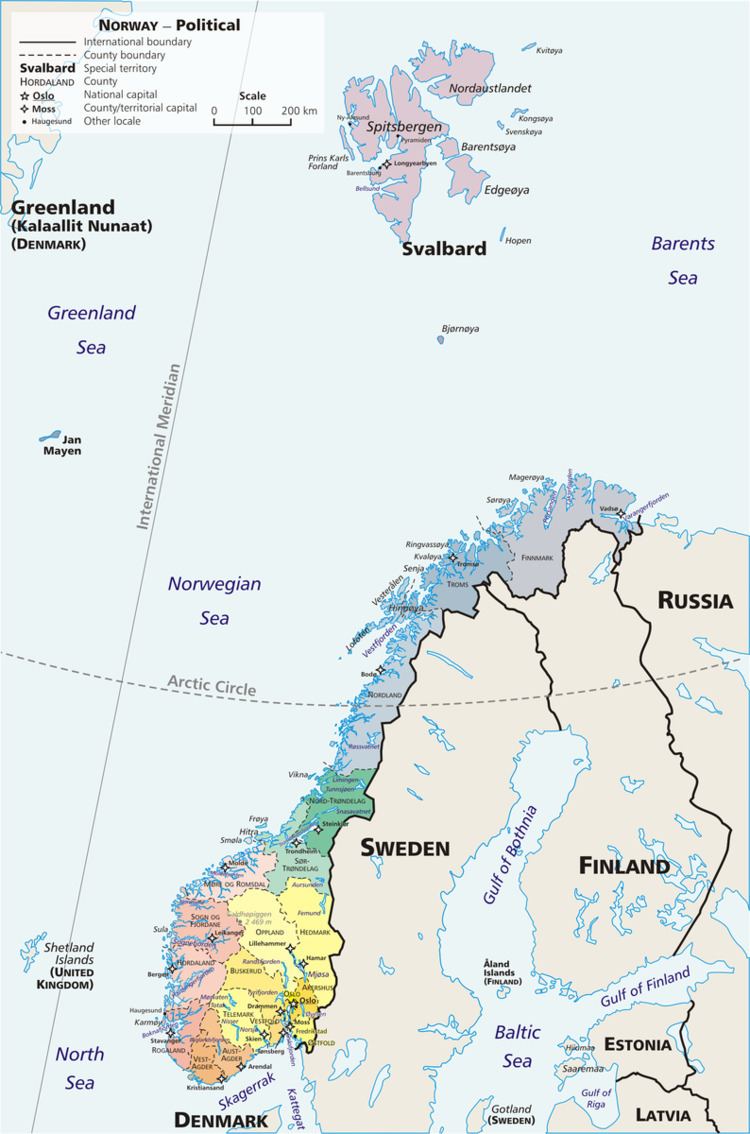 | ||
Norway is divided into 19 administrative regions, called counties (singular Norwegian: fylke, plural Norwegian: fylker (Bokmål) / fylke (Nynorsk) from Old Norse: fylki from the word "folk"); until 1918, they were known as amter. The counties form the first-level subdivisions of Norway and are further divided into 428 municipalities (kommune, pl. kommuner / kommunar). Svalbard and Jan Mayen are outside the county division and ruled directly on national level. The capital Oslo is considered both a county and a municipality.
Contents
- List of counties
- Fylke 1st period
- Fylke in the 10th 13th centuries
- Syssel in 1300
- Len
- Len in 1536
- Len in 1660
- Amt
- Amt in 1671
- Amt in 1730
- Amt in 1760
- Fylke 2nd period
- Region
- Responsibilities and significance
- References
In recent years, there has been some political debate as to whether counties are a practical, economical, or even necessary level of administration. See politics of Norway for more information.
List of counties
Below is a list of the Norwegian counties as they have been since 1919, with their current administrative centres. Note that the counties are administered both by appointees of the national government and to a lesser extent by their own elected bodies. The county numbers are from the official numbering system ISO 3166-2:NO, which follows the coastline from the Swedish border in the southeast to the Russian border in the northeast. The number 13 was dropped from the system when the city of Bergen (county no. 13) was merged into Hordaland (county no. 12) in 1972. (There is no connection between the lack of a county number 13 and the belief that 13 is an unlucky number.)
Fylke (1st period)
From the consolidation to a single kingdom, Norway was divided into a number of geographic regions that had its own legislative assembly or Thing, such as Gulating (Western Norway) and Frostating (Trøndelag). The second-order subdivision of these regions was into fylker, such as Egdafylke and Hordafylke. In 1914, the historical term fylke was brought into use again to replace the term amt introduced during the union with Denmark. Current day counties (fylker) often, but not necessarily, correspond to the historical areas.
Fylke in the 10th-13th centuries
Finnmark (including northern Troms), the Faroe Islands, the Orkney Islands, Shetland, the Hebrides, Isle of Man, Iceland and Greenland were Norwegian skattland ("tax countries"), and did not belong to any known counties or assembly areas.
Syssel in 1300
From the end of the 12th century, Norway was divided into several syssel. The head of the various syssel was the syslemann, who represented the king locally. The following shows a reconstruction of the different syssel in Norway c. 1300, including sub-syssel where these seem established.
Len
From 1308, the term len (plural len) in Norway signified an administrative region roughly equivalent to today's counties. The historic len was an important administrative entity during the period of Dano-Norwegian unification after their amalgamation as one state, which lasted for the period 1536–1814.
At the beginning of the 16th century the political divisions were variable, but consistently included four main len and approximately 30 smaller sub-regions with varying connections to a main len. Up to 1660 the four principal len were headquartered at the major fortresses Bohus Fortress, Akershus Fortress, Bergenhus Fortress and the fortified city of Trondheim. The sub-regions corresponded to the church districts for the Lutheran church in Norway.
Len in 1536
These four principal len were in the 1530s divided into approximately 30 smaller regions. From that point forward through the beginning of the 17th century the number of subsidiary len was reduced, while the composition of the principal len became more stable.
Len in 1660
From 1660 Norway had nine principal len comprising 17 subsidiary len:
Len written as län continues to be used as the administrative equivalent of county in Sweden to this day. Each len was governed by a lenman.
Amt
With the royal decree of February 19, 1662, each len was designated an amt (plural amt) and the lenmann was titled amtmann, from German Amt (office), reflecting the bias of the Danish court of that period.
Amt in 1671
After 1671 Norway was divided into four principal amt or stiftsamt and there were nine subordinate amt:
Amt in 1730
From 1730 Norway had the following amt:
At this time there were also two counties (grevskap) controlled by actual counts, together forming what is now Vestfold county:
Amt in 1760
In 1760 Norway had the following stiftamt and amt:
Fylke (2nd period)
From 1919 each amt was renamed a fylke (plural fylker) (county) and the amtmann was now titled fylkesmann (county governor).
Region
In 2017 the Norwegian government announced a proposal to merge the existing 19 fylker into approximately 10 regions by 2020. Each region (plural regioner) would be led by a regionleder (region leader), which would be equivalent to the current position of fylkesmann.
Two potential new regions have already received support from leaders of the existing counties that would comprise those regions:
Responsibilities and significance
Every county has two main organisations, both with underlying organisations.
- The county municipality (no: Fylkeskommune) has a county council (Norwegian: Fylkesting), whose members are elected by the inhabitants. The county municipality is responsible mainly for some medium level schools, public transport organisation, regional road planning, culture and some more areas.
- The county governor (no: Fylkesmannen) is an authority directly overseen by the Norwegian government. It surveills the municipalities and receive complaints from people over their actions. It also controls areas where the government needs local direct ruling outside the municipalities.
